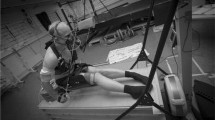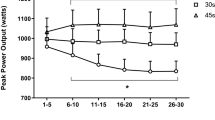Abstract
The aim of this study was to compare optimal pedalling velocities during maximal (OVM) and submaximal (OVSM) cycling in human, subjects with different training backgrounds. A group of 22 subjects [6 explosive (EX), 6 endurance (EN) and 10 non-specialised subjects] sprint cycled on a friction-loaded ergometer four maximal sprints lasting 6 s each followed by five 3-min periods of steady-state cycling at 150 W with pedalling frequencies varying from 40 to 120 rpm. The OVM and OVSM were defined as the velocities corresponding to the maximal power production and the lowest oxygen consumption, respectively. A significant linear relationship (r 2 = 0.52, P < 0.001) was found between individual OVM [mean 123.1 (SD 11.2) rpm] and OVSM [mean 57.0 (SD 4.9) rpm, P < 0.001] values, suggesting that the same functional properties of leg extensor muscles influence both OVM and OVSM. Since EX was greater than EN in both OVM and OVSM (134.3 compared to 110.9 rpm and 60.8 compared to 54.0 rpm, P < 0.01 and P < 0.05, respectively) it could be hypothesised that the distribution of muscle fibre type plays an important role in optimising both maximal and submaximal cycling performance.
Similar content being viewed by others
Author information
Authors and Affiliations
Additional information
Accepted: 20 October 1998
Rights and permissions
About this article
Cite this article
Hintzy, F., Belli, A., Grappe, F. et al. Optimal pedalling velocity characteristics during maximal and submaximal cycling in humans. Eur J Appl Physiol 79, 426–432 (1999). https://doi.org/10.1007/s004210050533
Issue Date:
DOI: https://doi.org/10.1007/s004210050533




